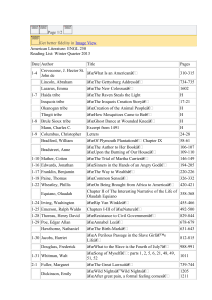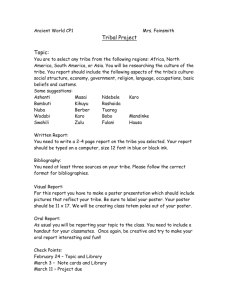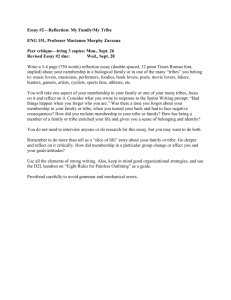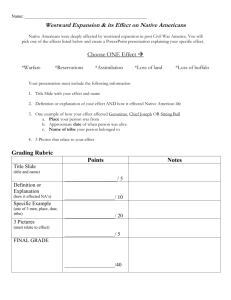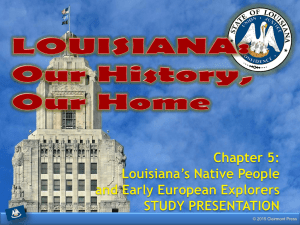Native Americans
advertisement
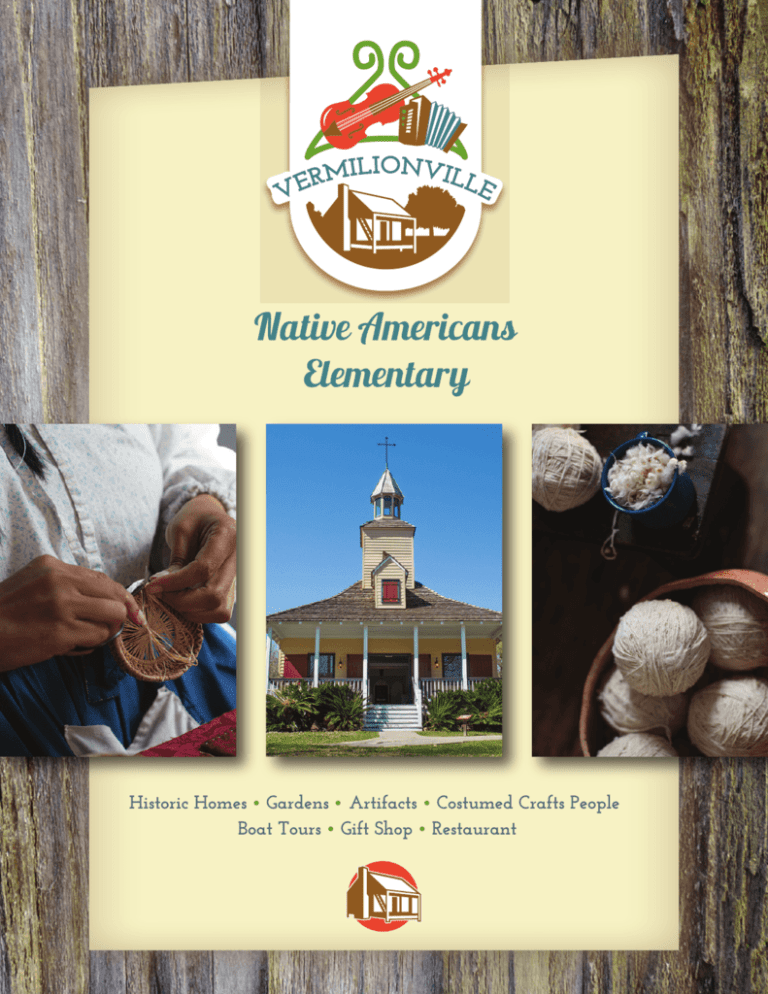
Native Americans Elementary Historic Homes • Gardens • Artifacts • Costumed Crafts People Boat Tours • Gift Shop • Restaurant Standards Standards as developed by the Louisiana Department of Education. Available online at http://www.vermilionville.org/vermilionville/educate/lesson-plans. Grade 3 Social Studies Places and Regions GLE #12: Use maps, charts, and pictures to describe how places in Louisiana are different (e.g. land use, vegetation, architecture) (G-1B-E4) Physical and Human Systems GLE #16: Identify and compare customs, celebrations, and traditions of various cultural groups in Louisiana (G-1C-E4) English Language Arts CCSS.ELA.literacy.W.3.8: Recall information from experiences or gather information from print and digital sources; take brief notes on sources and sort evidence into provided categories CCSS.ELA.literay.SL.3.1: Engage effectively in a range of collaborative discussions (one-on-one, in groups, and teacher-led) with diverse partners on grade 3 topics and texts, building on others’ ideas and expressing their own clearly CCSS.ELA.literacy.SL.3.1.a: Come to discussions prepared, having read or studied required material; explicitly draw on that preparation and other information known about the topic to explore ideas under discussion CCSS.ELA.literacy.SL.3.1.c: Ask questions to check understanding of information presented, stay on topic, and link their comments to the remarks of others CCSS.ELA.literacy.SL.3.1.d: Explain their own ideas and understanding in light of the discussion CCSS.ELA.literacy.SL.3.4: Report on a topic or text, tell a story, or recount an experience with appropriate facts and relevant, descriptive details, speaking clearly at an understandable pace Grade 4 Social Studies Families and Communities GLE #55: Describe beliefs, customs, and traditions of family life in the past and present (H-1B-E1) Louisiana and United States History GLE #61: Identify the causes and effects of the major historical (voluntary and involuntary) migrations to and within America (H-1C-E3, G-1C-E3) Objective Compare and contrast the customs and lifestyles of various Louisiana Native American groups. Pre-Visit Activity Materials needed: Native Americans Graphic Organizer (document #1, 2, or 3), pictures for each tribe (available at Vermilionville upon request) Teachers. We have made two introduction documents available to you on our website – a word document as well as a PowerPoint with pictures depicting the cultures that we represent. Please take some time to review these two documents with your class prior to your visit here. You can access them here, by clicking on Introduction to Vermilionville and Vermilionville PowerPoint Tell students that learning the history of where one comes from is beneficial for them. Native Americans were the first people present not only in the state of Louisiana, but in the entire North American continent. There are many different Native American tribes and they will learn more about three of them before their field trip to Vermilionville: the Natchez, the Chitimacha, and the Choctaw. Split the class into three groups. Each group will be assigned a different tribe (Natchez, Chitimacha, or Choctaw). Give each student the Native American Graphic Organizer (document #1, #2, or #3). You will decide which document to give your students, depending on if you want them to write the categories themselves or not. Then, give each group a bag of pictures identified with their tribe. Tell students to categorize the pictures by common aspects or features. Once all pictures are categorized, the students will write down the name of their categories on their handout (unless you give the handout that already has them written on it). Ask students to look and analyze the pictures with their team members and come up with a word or short sentence that represents the category. Then, they will write that down on their handout, under their respective tribe. Younger students might have a hard time with this, so you should expect to guide them in their discussion. As students are categorizing their pictures, walk around and explain more about the tribe using the following notes. Natchez FOOD/FARMING/HUNTING Depended heavily on agriculture. They raised crops of corn, beans, pumpkins, and squash. Natchez men also hunted deer, wild turkeys, and buffalo and went fishing in the rivers. Natchez recipes included cornbread, hominy, and soups. DRESS/CLOTHING Men wore leggings. Women wore wraparounds skirts made of deerskin or woven fiber. Shirts were not necessary in Natchez culture, but both men and women wore tunics in cooler weather. The Great Sun wore a fancy feathered crown, but other Natchez men usually went bareheaded. Some Natchez warriors shaved their heads except for a scalp lock (one lock of hair on top of their heads). Women usually wore their hair in one long braid or wrapped it up in a bun like the neighboring Creeks. Natchez men and women both painted their faces for special occasions and also decorated their bodies with complex tribal tattoos. TRANSPORTATION They made long dugout canoes from hollowed-out cypress logs. Over land, the Natchez used dogs as pack animals. The Great Sun always rode in a litter, which is a special kind of carriage carried on the shoulders of other man. TRADITIONS Ruled by a king, The Great Sun. Men were higher-ranking than women, held leadership positions, were in charge of the household, and even got to eat first. However, both genders took part in storytelling, artwork and music, and traditional medicine. WEAPONS & TOOLS Used bows and arrows or spears. Fishermen used fishing harpoons and nets. Farmers used hoes carved from hickory wood. In war, Natchez men fired their bows or fought with tomahawks and war clubs. Natchez warriors sometimes used hide shields to defend themselves. LANGUAGES They spoke Natchez but nowadays, the language is generally considered extinct. ENTERTAINMENT Children had cornhusk dolls, toys and games to play with. Teenage boys played a spear-throwing game called chunkey. Storytelling was very important to the Natchez people so they told lots of legends and fairy tales. LOCATION OF TRIBE Original residents of Louisiana and Mississippi. EXTRA The Natchez have a traditional form of government dating back very long before European contact. It can be considered the oldest continually functioning government on the face of the earth. Chitimacha FOOD/FARMING/HUNTING Women harvested crops of corn, beans, sweet potatoes, and squash. Corn was their main harvest. Men hunted for deer, wild turkeys, alligators, and fished for all kinds of seafood. DRESS/CLOTHING The men wore breech clothing and leather leggings. The women wore wrap-around skirts made of deerskin or woven fiber. Shirts were not necessary in the culture. Moccasins were worn as shoes. TRANSPORTATION Dugout canoes from hallowed out cypress logs. TRADITIONS River cane basketry. Both single and double women. WEAPONS & TOOLS The hunters used bows and arrows or blow guns. Fishermen used nets, traps, and hooks made of bone. LANGUAGES They spoke French and English. In the past, they spoke their own Chitimacha language. LOCATION OF TRIBE St. Mary Parish, Louisiana EXTRA The women were farmers. Choctaw ABOUT They are originally form Mississippi, Alabama, Louisiana, and Florida. Most were forced to move to Oklahoma in the 1800s, their descendants still live there today. Some escaped moving by hiding or pretending to be white, their descendants are still living in the original Choctaw homelands. ENTERTAINMENT The Choctaws were known for their beaded artwork, river-cane baskets, and woodcarvings. The children played guessing games, football, stickball, and foot races. The girls also enjoyed beaded dolls. WEAPONS & TOOLS They primarily used bows and arrows. Fishermen used fishing spears and nets. They also fought with tomahawks and clubs. TRANSPORTATION Before colonists brought horses from Europe, Choctaws used dogs to help them carry their belongings. They also carved out wooden logs to make canoes. FAMILY Before colonization, women held great positions of respect, esteem, and power. They were recognized as the givers and supporters of life. They were highly valued and fulfilled many important roles in their communities, families, and tribes. Moreover, expecting mothers were revered, men fasted for them and children who teased them were severely reprimanded. Family lines followed the female rather than the male (opposite of American society). Women often went with their husbands on diplomatic missions to other tribes and Euro-American groups. The men still protected the community, fought, and killed, but there are records of women carrying weapons to protect their families, tracking enemies, and encouraging their men on the battlefield. CLOTHING & HAIR TRADITIONS Choctaw men wore breech cloths and women wore wrap-around skirts made of deerskin or woven fiber. Shirts were not needed in their culture, but they did wear poncho-style capes in cool weather. They also wore moccasins. Both men and women wore their hair long. Some men cut their hair in the Mohawk style. They did not wear long head dresses like many other Native Americans. TRAIL OF TEARS The “Trail of Tears” is the American Indian Removal during the 1800s to Oklahoma. Some went willingly and some were forced. Some were moved by wagon and some had to walk. Many died en route due to cold weather, starving, and other ailments. THE LIGHTHORSEMEN They were a hard fighting body of men with a reputation of straight shooting and hard riding. They were organized in 1824 with a purpose of settling difficulties. They had the authority to arrest, try, and punish violators of tribal law. By the mid-1800s, they had lost judicial duties, but could still make arrests and sentence outlaws in court. By the beginning of the 20 th century, their main job was to simply keep peace. Now, they serve in the Tribal Court System. OTHER TRADITIONS Choctaw mothers carried their babies in cradleboards on their backs. Some Choctaw men wore tribal tattoos on their arms and legs. EXTRA During a very challenging time for their own people, the Choctaw gave $170 to the Irish during the potato famine. Although they had been removed through the trail of tears, lost many of their own people, and had very little to spare, the Choctaw did all they could to help the people they learned were perishing through starvation. The people of Ireland never forgot the generosity of the Choctaw people. As students are learning about their tribe, they should be taking notes on their Native American Graphic Organizer handout. Students will then participate in a role-play activity. Each group will decide on their own “chief”. Each tribe will then review their notes/information/graphic organizer and make sure their chief knows all about its tribe. Then, all three chiefs will meet in a pow-wow. There, they will mingle and teach one another about their specific tribe. Since they are acting as their tribe’s chief, they will speak in first person. The rest of the tribe members will be positioned around them and they will remain quiet, observing the meeting of the chiefs. Anchor Lesson When you come to Vermilionville for a walking tour, we encourage you to ask questions about the influence of the Native Americans during our time period (1765-1890). Also, you could request to visit with Chief John Mayeux who is an Avogel tribe member. He could guide your group or be present on site to talk with you about Native Americans. Please call us ahead of your visit to set up Chief Mayeux as a guide (337-233-4077). Post-Visit Activity Materials needed: Art Activity (document #4), glue or tape, scissors, pictures for each tribe (available at Vermilionville upon request) When you return from your field trip, put students back into their original group and give them back the pictures for each tribe. Let them look at them for a few minutes as they remember their tribe’s characteristics. Then, guide a whole-class discussion, starting with each chief telling the rest of the class about its tribe. When all three chiefs have spoken, proceed with the following guided-questions. What are some similarities between the three tribes? What are some differences between the three tribes? Do you think these tribe members still live like that today? After, have each student choose one characteristic of their tribe that they find interesting and have them illustrate it on a blank sheet of paper. When they are done, ask students if they want to volunteer and share their drawing with the class. Finally, have students do the art activity (document #4). Evaluation Monitor student learning by asking questions throughout the different activities. Students will display their artistic skills by doing the art activity (document #4). Differentiation of Instruction Tactile learners will benefit from touching the pictures and working with graphic organizers. Visual learners will benefit from categorizing the pictures into different categories. Social learners will benefit by working together to analyze the pictures. Auditory learners will benefit as acting as chiefs and discussing with their classmates. Kinesthetic learners will benefit by participating in the Pow-Wow. Document #1 – Native American Graphic Organizer Document #2 – Native American Graphic Organizer Natchez Chitimacha Choctaw Document #3 – Native American Graphic Organizer Natchez Food, Farming, & Hunting Clothing Shelter Transportation Traditions Weapons & Tools Languages Entertainment Location Interesting Facts Chitimacha Choctaw Document #4 – Art Activity
